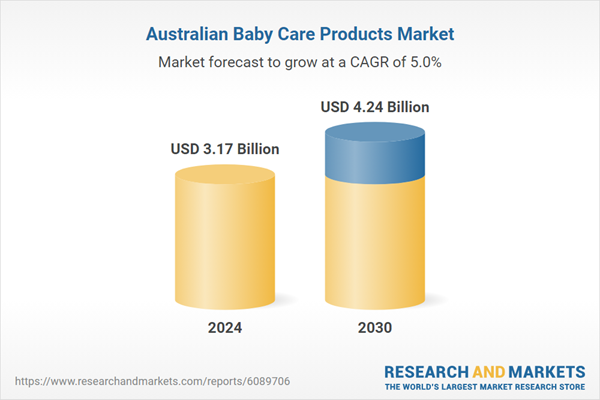Free Webex Call
The Australia Baby Care Products Market was valued at USD 3.17 Billion in 2024, and is expected to reach USD 4.24 Billion by 2030, rising at a CAGR of 5.03%. The market is undergoing rapid transformation, fueled by evolving consumer behavior, increased digital engagement, and a growing emphasis on health and sustainability. Parents are showing a strong preference for natural, organic, and environmentally friendly products, aligning with broader wellness and ecological values. Australia's robust organic agriculture sector and environmentally conscious population further support this trend. E-commerce is significantly shaping purchasing patterns by offering convenience and a wide product selection. Additionally, stringent regulatory standards ensure high product safety, reinforcing consumer confidence and promoting market expansion. Speak directly to the analyst to clarify any post sales queries you may have.
10% Free customizationThis report comes with 10% free customization, enabling you to add data that meets your specific business needs.
Key Market Drivers
Rising Parental Awareness and Demand for Premium Products
Australian parents are increasingly focused on acquiring safe, high-quality baby care products, driven by heightened awareness of infant health and hygiene. Millennials and Gen Z consumers, in particular, conduct thorough research before purchasing, favoring products that are free from toxins, artificial scents, and allergens. This trend has led to growing demand for premium, hypoallergenic, and dermatologically tested items such as baby lotions, diapers, and feeding gear. Parents are more inclined to purchase from brands that emphasize transparency and safety, including both international labels and niche local companies. Brands offering detailed ingredient information and scientifically validated formulations are gaining trust and market share. Support from pediatric health campaigns and professional advice has further strengthened consumer interest in premium baby care options.Key Market Challenges
Declining Birth Rate and Slowing Population Growth
A major hurdle for the Australia Baby Care Products Market is the country's declining birth rate, as highlighted by consistent decreases in fertility reported by the Australian Bureau of Statistics. This demographic trend results in a smaller consumer base for baby-related goods, directly affecting sales of diapers, lotions, and other essentials. Economic pressures - such as rising living and childcare costs - and a tendency to delay parenthood are also contributing to reduced birth rates. These conditions intensify competition among brands for a limited audience. As a response, companies are reassessing their growth strategies, often expanding into adjacent segments like maternal or toddler care to sustain their market presence and revenue.Key Market Trends
Emphasis on Sustainability and Ethical Sourcing
Sustainability has become a central concern for Australian consumers, particularly when purchasing baby care products. Parents are increasingly considering environmental impact, ethical sourcing, and waste reduction when selecting products. This has prompted brands to shift toward sustainable practices, such as using biodegradable ingredients, recyclable packaging, and adopting carbon-neutral operations. Products like bamboo-based diapers, reusable cloth options, and refillable containers are gaining traction. Moreover, consumers are paying attention to companies' commitments to fair trade and reducing plastic use. These environmentally driven preferences are reshaping product development and corporate responsibility strategies across the industry.Key Market Players
- The Procter & Gamble Company
- Kimberly-Clark Corporation
- Johnson & Johnson Services, Inc.
- Unilever plc
- Unicharm Corporation
- Himalaya Wellness Company
- Danone S.A.
- Laboratoires Expanscience (Mustela)
- Artsana S.p.A.
- Sebapharma GmbH & Co. KG
Report Scope:
In this report, the Australia Baby Care Products Market has been segmented into the following categories, in addition to the industry trends which have also been detailed below:Australia Baby Care Products Market, By Product Type:
- Skin Care
- Toiletries
- Hair Care
- Food & Beverages
- Others
Australia Baby Care Products Market, By Age Group:
- 0-12 Months
- 13-24 Months
- 24-48 Months
Australia Baby Care Products Market, By Sales Channel:
- Supermarkets/Hypermarkets
- Specialty Stores
- Pharmacies/Drug Stores
- Online
- Others
Australia Baby Care Products Market, By Region:
- Australia Capital Territory & New South Wales
- Northern Territory & Southern Australia
- Western Australia
- Queensland
- Victoria & Tasmania
Competitive Landscape
Company Profiles: Detailed analysis of the major companies present in the Australia Baby Care Products Market.Available Customizations:
With the given market data, the publisher offers customizations according to a company's specific needs. The following customization options are available for the report.Company Information
- Detailed analysis and profiling of additional market players (up to five).
This product will be delivered within 1-3 business days.
Table of Contents
1. Introduction
2. Research Methodology
3. Executive Summary
4. Voice of Customer Analysis
5. Australia Baby Care Products Market Outlook
6. Australia Skin Care Market Outlook
7. Australia Toiletries Market Outlook
8. Australia Hair Care Market Outlook
9. Australia Food & Beverages Market Outlook
10. Market Dynamics
11. Market Trends & Developments
14. Competitive Landscape
Companies Mentioned
- The Procter & Gamble Company
- Kimberly-Clark Corporation
- Johnson & Johnson Services, Inc.
- Unilever plc
- Unicharm Corporation
- Himalaya Wellness Company
- Danone S.A.
- Laboratoires Expanscience (Mustela)
- Artsana S.p.A.
- Sebapharma GmbH & Co. KG
Table Information
| Report Attribute | Details |
|---|---|
| No. of Pages | 81 |
| Published | May 2025 |
| Forecast Period | 2024 - 2030 |
| Estimated Market Value ( USD | $ 3.17 Billion |
| Forecasted Market Value ( USD | $ 4.24 Billion |
| Compound Annual Growth Rate | 5.0% |
| Regions Covered | Australia |
| No. of Companies Mentioned | 10 |









